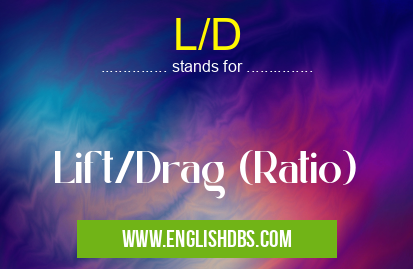What does L/D mean in MILITARY
Lift and drag are two of the most important aerodynamic forces that affect the performance of an airplane. Lift represents an upward force, while drag opposes the motion of the plane and can significantly hinder its performance. The lift/drag (L/D) ratio is a measure that expresses the amount of lift created by an aircraft compared to its amount of drag, otherwise known as its efficiency. It is typically expressed as a decimal number which indicates how well an aircraft utilizes the air to generate lift or thrust. Knowing and understanding this number can provide invaluable insight into the design, performance and efficiency of an aircraft

L/D meaning in Military in Governmental
L/D mostly used in an acronym Military in Category Governmental that means Lift/Drag (Ratio)
Shorthand: L/D,
Full Form: Lift/Drag (Ratio)
For more information of "Lift/Drag (Ratio)", see the section below.
» Governmental » Military
Essential Questions and Answers on Lift/Drag (Ratio) in "GOVERNMENTAL»MILITARY"
What is Lift/Drag (L/D) ratio?
The lift/drag ratio or L/D ratio describes how efficient an aircraft is in converting the power it produces into forward thrust. It is the ratio between the lift force generated by the aircraft and its drag force. A higher L/D ratio means that more of the power produced by the aircraft is being converted into lift, making for a more efficient flight.
How does Lift/Drag (L/D) affect flying performance?
The greater the L/D ratio of an aircraft, the better its performance in terms of range, speed, and fuel efficiency due to less drag resistance from air molecules. As such, increasing your L/D ratio can provide significant improvements to your aerial performance.
How important is Lift/Drag (L/D) for gliders?
For gliders, having a high L/D is essential for achieving long-range flights. As gliders can not produce any thrust on their own but rely on aerodynamic forces to stay airborne, they benefit greatly from improved efficiency provided by a higher L/D ratio when it comes to conserving energy during long flights.
What shapes have a good Lift/Drag (L/D) Ratio?
Streamlined body shapes tend to have better aerodynamic properties and hence are able to generate higher lift with less drag compared to other shapes. Examples of such streamlined shapes include darts, spindles and boomerangs which have excellent L/D ratios due to their shape alone; no further modifications needed!
How do wings affect Lift/Drag (L/D) Ratio?
Wings are one of the most important components for improving the L/D ratio as they create lift at low speeds thanks to their curved design which modifies airflow over them. The curvature on wings increases pressure below them compared to above them which creates an upwards force known as lift allowing for improved flight performance with less drag resistance from air molecules.
How do you calculate Lift Drag Ratio (L / D)?
The lift-to-drag ratio can be calculated by dividing total lift force generated by the aircraft divided by total drag resistance encountered during flight. This calculation gives us a numerical value representing how efficiently our aircraft is converting energy into motion and can be used as an indicator of overall flight performance.
